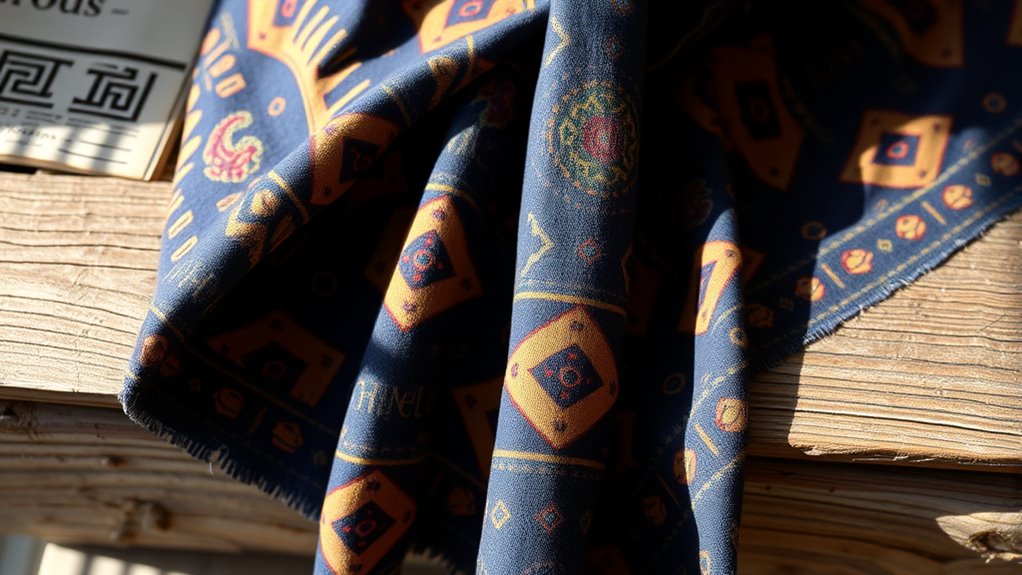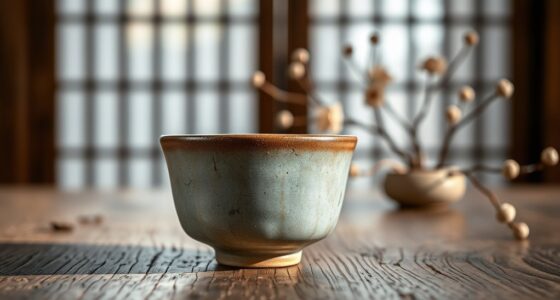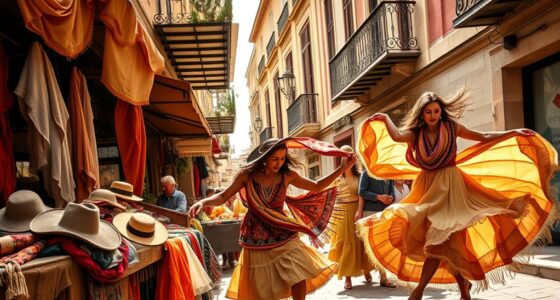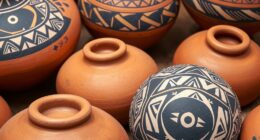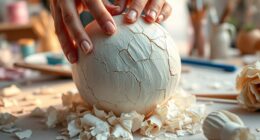African mudcloth and indigo textiles add rich cultural depth to boho decor. You can incorporate these handcrafted fabrics as wall hangings, pillows, or upholstery, bringing texture and meaningful storytelling into your space. The intricate patterns and earthy tones honor tradition while enhancing your eclectic style. Each piece is unique, crafted using natural dyes and centuries-old techniques. Keep exploring to discover how these textiles can transform your home into a vibrant celebration of craftsmanship and heritage.
Key Takeaways
- African mudcloth and indigo textiles add authentic, meaningful textures and patterns to boho decor, celebrating cultural heritage.
- Traditional craftsmanship involves natural dyes, fermented mud, and resist dyeing techniques, making each piece unique.
- Incorporating these textiles as pillows, wall hangings, or upholstery enhances the eclectic, curated vibe of boho interiors.
- These textiles embody artistry, storytelling, and cultural symbolism, connecting interiors to African history and traditions.
- Using mudcloth and indigo fabrics emphasizes craftsmanship, patience, and the cultural significance behind each handmade textile.
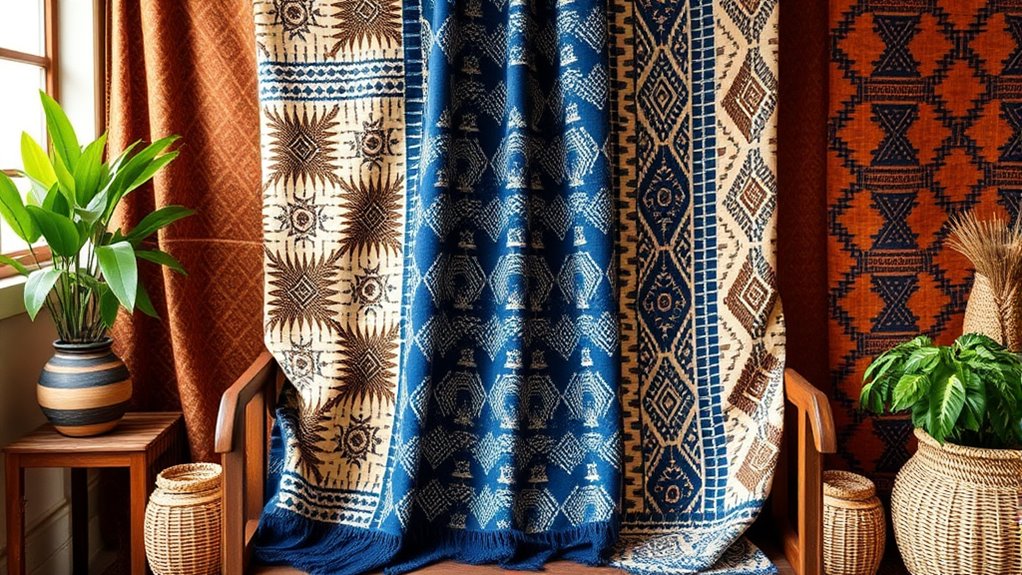
Traditional textiles play an essential role in creating the relaxed, eclectic vibe that defines boho decor. When you incorporate pieces like African mudcloth and indigo-dyed fabrics, you’re bringing more than just color and texture into your space—you’re adding layers of history, meaning, and artistry. These textiles are steeped in cultural symbolism, with each pattern and motif holding specific stories or beliefs. For example, mudcloth, or bogolanfini, originates from Mali and is traditionally crafted by the Bamana people. The symbols woven into the fabric often represent social status, historical events, or spiritual beliefs, giving your decor a meaningful connection to African heritage. By choosing these textiles, you’re not only decorating your home but also honoring a rich cultural legacy.
The craftsmanship techniques behind these textiles are as enthralling as their visual appeal. Mudcloth, for instance, involves a labor-intensive process that has been passed down through generations. Artisans start with hand-spun cotton fabric, which they treat with fermented mud and natural dyes made from plants like indigo and mud. The fabric is repeatedly soaked, stamped, and dyed, creating the characteristic earthy tones and irregular patterns. This technique results in a one-of-a-kind piece that embodies the skill, patience, and tradition of its maker. Similarly, indigo textiles are crafted using traditional dyeing methods that require precision and expertise. The fabric is dipped multiple times into a vat of indigo dye, with each immersion deepening the hue. Artists often create intricate patterns through resist dyeing techniques like tying, folding, or stitching, which prevent certain areas from absorbing the dye. The result is a stunning contrast of vibrant blue and white, with each piece showcasing the artisan’s mastery. Additionally, these textiles often feature authentic craftsmanship that emphasizes their uniqueness and cultural significance.
Incorporating these textiles into your boho decor allows you to celebrate craftsmanship techniques and cultural symbolism. They add depth and authenticity to your space, making it feel curated and meaningful. Whether you use mudcloth as a throw pillow, wall hanging, or upholstery, or showcase indigo textiles as curtains or bed linens, you’re creating an environment that’s both stylish and rooted in tradition. These textiles do more than decorate—they tell a story, connect you to distant cultures, and highlight the incredible skills of artisans who keep these techniques alive. By choosing African mudcloth and indigo fabrics, you’re embracing the spirit of boho decor—free-spirited, eclectic, and deeply meaningful.
Frequently Asked Questions
How Do African Mudcloth and Indigo Fabrics Influence Modern Interior Design?
African mudcloth and indigo fabrics influence your modern interior design by adding rich cultural storytelling and a touch of artistic innovation. They create a warm, textured ambiance that instantly transforms your space into a vibrant, authentic environment. By incorporating these textiles, you celebrate tradition while embracing contemporary style, making your decor uniquely personal and visually enthralling. These fabrics effortlessly blend heritage and modernity, giving your home a distinctive, globally inspired aesthetic.
What Are the Best Ways to Care for and Clean Traditional African Textiles?
Treat your traditional African textiles like a fragile butterfly. You should wash them gently by hand in cold water, avoiding harsh detergents. After cleaning, air dry them naturally—no tumble dryers needed. Keep them out of direct sunlight to prevent fading. With tender loving care, your textiles will stay vibrant and beautiful, telling their stories for generations to come. Remember, patience is key when preserving these treasures.
Can Mudcloth and Indigo Textiles Be Incorporated Into Outdoor Decor?
Yes, you can incorporate mudcloth and indigo textiles into outdoor decor, but prioritize outdoor durability and weather resistance. Use protective coatings or sealants to shield the textiles from moisture and UV rays, and place them in covered areas to extend their lifespan. Regularly clean and store them indoors during harsh weather. With proper care, these vibrant textiles add unique, cultural charm to your outdoor space.
Are There Regional Differences in the Patterns and Symbolism of These Textiles?
Yes, you’ll notice regional differences in mudcloth and indigo textiles, especially in their patterns and symbolism. You’ll see distinct regional motifs that reflect local stories, beliefs, and cultural symbolism, making each piece unique. When you incorporate these textiles into your decor, you’re embracing their rich cultural meanings, which vary by region. This adds depth and authenticity to your boho style, celebrating diverse African traditions through visual storytelling.
How Sustainable Are the Production Methods of African Traditional Textiles?
Sustainable practices considerably shape the production of these textiles, ensuring eco-friendly efforts flourish. You’ll find artisans passionately preserving traditional methods that prioritize minimal environmental impact, boosting artisan livelihoods. By choosing ethically made textiles, you support sustainability and social fairness. These time-honored techniques, rooted in respect for nature and culture, promote a cleaner, conscious craft that sustains both the environment and the skilled hands behind each piece, making your decor both beautiful and responsible.
Conclusion
So, next time you’re tossing that bland throw pillow onto your couch, remember—you could be embracing the vibrant magic of African mudcloth and indigo. Who needs boring decor when you can channel centuries of culture, tradition, and a dash of boho rebellion? Trust me, your living room (and your Instagram followers) will thank you for finally giving your space a splash of authentic, colorful personality—because plain just isn’t your style.

